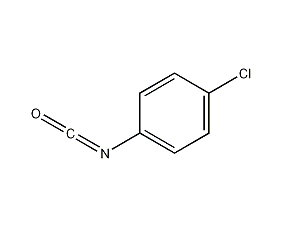4-Chlorophenyl isocyanate 4-Chlorophenyl isocyanate


Structural formula
| Business number | 02PQ |
|---|---|
| Molecular formula | C7H4ClNO |
| Molecular weight | 153 |
| label |
4-Chlorophenyl isocyanate, p-Chlorobenzene isocyanate, p-chlorophenyl isocyanate, 1-Chloro-4-isocyanato-benzen, 1-Chloro-4-isocyanatobenzene |
Numbering system
CAS number:104-12-1
MDL number:MFCD00002024
EINECS number:203-176-9
RTECS number:NQ8575000
BRN number:386235
PubChem number:24855448
Physical property data
1. Properties: colorless to slightly yellow liquid or crystal
2. Density (g/mL, 20℃): 1.200
3. Relative vapor density (g/ mL, air=1): Undetermined
4. Melting point (ºC): 26-29
5. Boiling point (ºC, normal pressure): 203-204
6. Boiling point (ºC, kPa): Undetermined
7. Refractive index: 1.5618
8. Flash point (ºC): 60
9. Specific rotation (º): Undetermined
10. Autoignition point or ignition temperature (ºC): Undetermined
11. Vapor pressure (mmHg, 20.2ºC): Undetermined
12. Saturated vapor pressure (kPa, ºC): Undetermined
13. Heat of combustion (KJ/mol): Undetermined
14. Critical temperature (ºC): Undetermined
15. Critical pressure (KPa): Undetermined
16. Log value of oil-water (octanol/water) partition coefficient: Undetermined
17. Explosion upper limit (%, V/V): Undetermined
18. Explosion lower limit (%, V/V): Undetermined
19. Solubility: Not determined
Toxicological data
1. Acute toxicity: Rat oral LD5O: 138mg/kg
Mouse oral LD5O: 450mg/kg
Rat dermal LD: >1000mg/kg
Rabbit LDLO: 6GM/KG
Mouse inhaled LC5O: 53mg/m3
Ecological data
It is extremely harmful to water and toxic to fish. Do not let the product enter the water body.
Molecular structure data
1. Molar refractive index: 40.75
2. Molar volume (cm3/mol): 127.8
3. Isotonic specific volume (90.2K ): 324.0
4. Surface tension (dyne/cm) 41.3
5. Dielectric constant:
6. Dipole moment (10-24cm3):
7, Polarizability: 16.15
Compute chemical data
1. Reference value for hydrophobic parameter calculation (XlogP): None
2. Number of hydrogen bond donors: 0
3. Number of hydrogen bond acceptors: 2
4. Number of rotatable chemical bonds: 1
5. Number of tautomers: none
6. Topological molecule polar surface area 29.4
7. Number of heavy atoms: 10
8. Surface charge: 0
9. Complexity: 146
10. Number of isotope atoms: 0
11. Determine the number of atomic stereocenters: 0
12. Uncertain number of atomic stereocenters: 0
13. Determine the number of chemical bond stereocenters: 0
14. Number of uncertain chemical bond stereocenters: 0
15. Number of covalent bond units: 1
Properties and stability
Avoid contact with oxides, amines, alcohol, and water.
Storage method
Store in a cool, ventilated warehouse. Keep away from fire, heat and water sources. Keep container tightly sealed. should be kept away from oxidizer, do not store together. Equipped with the appropriate variety and quantity of fire equipment. Suitable materials should be available in the storage area to contain spills.
Synthesis method
The preparation method is to add p-chloroaniline and toluene into the reaction kettle, stir to dissolve p-chloroaniline, then pass phosgene at low temperature, pass in a certain amount of phosgene, then transfer to the thermal reactor, and raise the temperature to 105°C After about 10 seconds, the material becomes transparent, and then refluxes for a certain period of time. Nitrogen is introduced to drive out phosgene, and the product is obtained by cooling.
Purpose
Used in organic synthesis, mainly used as intermediates for medicines, pesticides, etc.